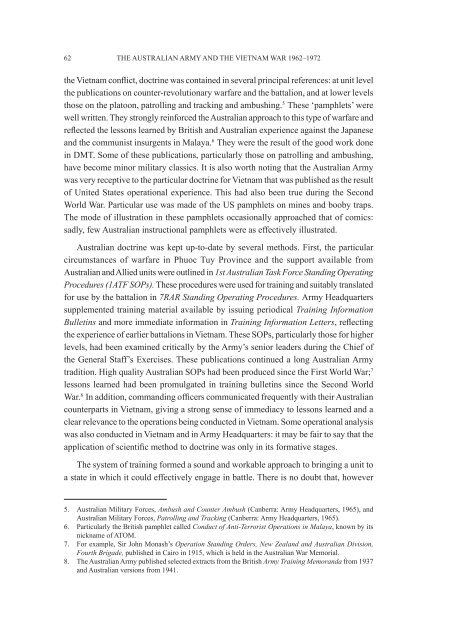conference proceedings - Australian Army
conference proceedings - Australian Army
conference proceedings - Australian Army
You also want an ePaper? Increase the reach of your titles
YUMPU automatically turns print PDFs into web optimized ePapers that Google loves.
62<br />
THE AUSTRALIAN ARMY AND THE VIETNAM WAR 1962–1972<br />
the Vietnam conflict, doctrine was contained in several principal references: at unit level<br />
the publications on counter-revolutionary warfare and the battalion, and at lower levels<br />
those on the platoon, patrolling and tracking and ambushing. 5 These ‘pamphlets’ were<br />
well written. They strongly reinforced the <strong>Australian</strong> approach to this type of warfare and<br />
reflected the lessons learned by British and <strong>Australian</strong> experience against the Japanese<br />
and the communist insurgents in Malaya. 6 They were the result of the good work done<br />
in DMT. Some of these publications, particularly those on patrolling and ambushing,<br />
have become minor military classics. It is also worth noting that the <strong>Australian</strong> <strong>Army</strong><br />
was very receptive to the particular doctrine for Vietnam that was published as the result<br />
of United States operational experience. This had also been true during the Second<br />
World War. Particular use was made of the US pamphlets on mines and booby traps.<br />
The mode of illustration in these pamphlets occasionally approached that of comics:<br />
sadly, few <strong>Australian</strong> instructional pamphlets were as effectively illustrated.<br />
<strong>Australian</strong> doctrine was kept up-to-date by several methods. First, the particular<br />
circumstances of warfare in Phuoc Tuy Province and the support available from<br />
<strong>Australian</strong> and Allied units were outlined in 1st <strong>Australian</strong> Task Force Standing Operating<br />
Procedures (1ATF SOPs). These procedures were used for training and suitably translated<br />
for use by the battalion in 7RAR Standing Operating Procedures. <strong>Army</strong> Headquarters<br />
supplemented training material available by issuing periodical Training Information<br />
Bulletins and more immediate information in Training Information Letters, reflecting<br />
the experience of earlier battalions in Vietnam. These SOPs, particularly those for higher<br />
levels, had been examined critically by the <strong>Army</strong>’s senior leaders during the Chief of<br />
the General Staff’s Exercises. These publications continued a long <strong>Australian</strong> <strong>Army</strong><br />
tradition. high quality <strong>Australian</strong> soPs had been produced since the First World War; 7<br />
lessons learned had been promulgated in training bulletins since the Second World<br />
War. 8 In addition, commanding officers communicated frequently with their <strong>Australian</strong><br />
counterparts in Vietnam, giving a strong sense of immediacy to lessons learned and a<br />
clear relevance to the operations being conducted in Vietnam. Some operational analysis<br />
was also conducted in Vietnam and in <strong>Army</strong> Headquarters: it may be fair to say that the<br />
application of scientific method to doctrine was only in its formative stages.<br />
The system of training formed a sound and workable approach to bringing a unit to<br />
a state in which it could effectively engage in battle. There is no doubt that, however<br />
5. <strong>Australian</strong> military Forces, Ambush and Counter Ambush (Canberra: <strong>Army</strong> headquarters, 1965), and<br />
<strong>Australian</strong> military Forces, Patrolling and Tracking (Canberra: <strong>Army</strong> headquarters, 1965).<br />
6. Particularly the British pamphlet called Conduct of Anti-Terrorist Operations in Malaya, known by its<br />
nickname of ATOM.<br />
7. For example, sir John monash’s Operation Standing Orders, New Zealand and <strong>Australian</strong> Division,<br />
Fourth Brigade, published in Cairo in 1915, which is held in the <strong>Australian</strong> War memorial.<br />
8. The <strong>Australian</strong> <strong>Army</strong> published selected extracts from the British <strong>Army</strong> Training Memoranda from 1937<br />
and <strong>Australian</strong> versions from 1941.

















